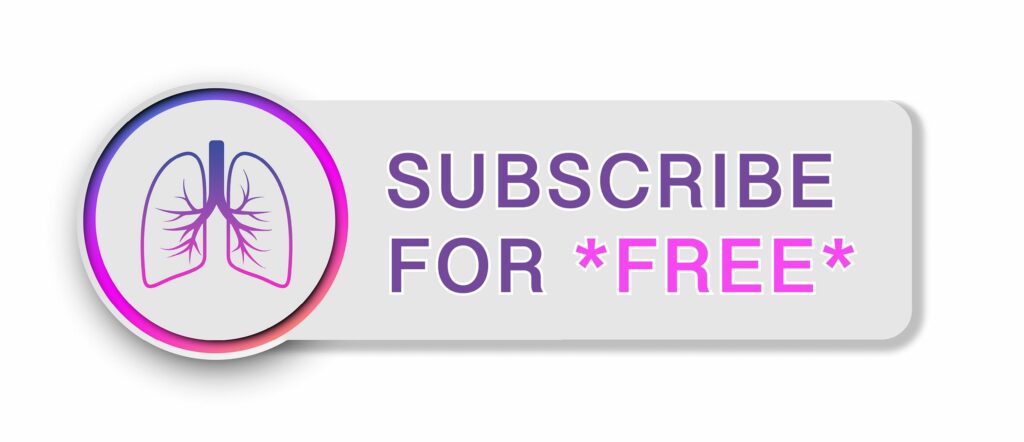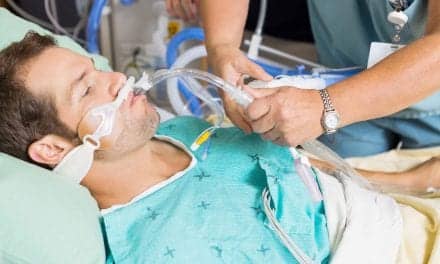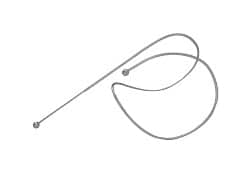A respiratory therapist presents 10 important things to consider when performing endotracheal suctioning, including depth of catheter insertion, suction catheter size, and more.
By Michael Hahn, RPFT, RRT-NPS
The purpose of this review is to help respiratory therapists become more aware of 10 important factors to consider when performing endotracheal suctioning (ETS). Awareness and application of evidence-based knowledge practices in respiratory therapy is ideal, because it demonstrates to patients and peers that procedures are being performed according to scientifically proven methods.
Following is a brief summary of 10 considerations that may provide some assistance in determining what the best practice methods are for performing ETS.

1. Frequency of Suctioning
Although there has been a very limited number of studies regarding a scheduled frequency of performing ETS every 1, 3, 4, 6, 8, or even 12 hours, the overall recommendation is to suction only as indicated (as needed).1-3 The reason for this is because there is considerable risk with using “routine” suctioning. It has been suggested by Pedersen et al3 that ETS should be performed at least every 8 hours to slow the formation of the secretion biofilm within the lumen of the endotracheal tube (ETT). Clifton-Koeppel1 made a good general recommendation that ETS should be performed as infrequently as possible—yet as much as needed.
2. Preoxygenation
In general, studies have not yet shown the optimal level or duration for the use of preoxygenation for ETS.4 In adults, the common practice is to preoxygenate with 100% oxygen before, during, and for some period after performing ETS.1,3 Prolonged hyperoxia may lead to free-radical tissue damage, absorption atelectasis (nitrogen washout), and loss of lung volume.2,3 In preterm infants, the practice of using 100% oxygen is avoided because of the possible deleterious effects of hyperoxia that can cause retinopathy of prematurity.1,2 Also in preterm infants, the level of brain oxygenation decreases in parallel with the drop in oxygen saturation, but is also ameliorated with a sustained increase of 10% in the oxygen setting.2 Also in infants there is a possibility of bradycardia and apnea when preoxygenation is not provided.2 Therefore, many neonatal intensive care units (NICUs) have a protocol whereby the oxygen is increased by 10% to 20% before ETS.1 Another concern is providing hyperoxia to patients in cardiac units who have cyanotic heart disease, since the hyperoxia may cause pulmonary vascular dilation and decreased preload to the left heart resulting in systemic hypotension.5
3. Vacuum Pressure Level
Although studies of vacuum pressure of up to 360 mm Hg have shown positive results, the general recommendation is to use between 70 and 150 mm Hg—except when there are thick secretions, where up to 200 mm Hg is used with the appropriate suction catheter size.2,3 The actual negative pressure delivered at the tip of the ETT is not the same as the manometer setting since it depends on the size of the catheter and ETT, the duration of suction, and the volume and viscosity of the secretions.3 One interesting thing to note about ETS is that negative pressure is created inside of the lungs only while air flows out of the suction catheter.2,3 As soon as secretions are aspirated into the catheter, the intrapulmonary pressure returns to that of the atmospheric level, and lung volume loss stops.2 However, if ETS is performed when there are no secretions, it may cause significant atelectasis.2 Clinicians must weigh the impact of potential mucosal injury or other problems at a high vacuum level, or using repeated suction passes when a lower vacuum pressure is utilized.2 It is now generally recommended to use the lowest vacuum pressure to avoid the incidence or degree of hypoxia, atelectasis, and tracheal mucosa injury.3
4. Suction Catheter Size
If a suction catheter is too large for the ETT, and/or there is too much vacuum pressure, massive atelectasis may occur.2 Therefore, the general recommendation is to use a suction catheter that has an external diameter less than 50% of the size of the ETT inner diameter.2,3 In some cases, however, this recommendation is not possible—for example, with a size 2.5 or 3.0 ETT, since the smallest size suction catheter will occlude 75% of the ETT lumen.2 One method to calculate the French (Fr) suction catheter size is: Fr = (ETT size [mm] – 1) x 2, which is relatively accurate.6 A suction catheter with an outer diameter that occludes less than 40% of the ETT internal diameter may be insufficient to clear secretions, necessitating the use of multiple passes.1 Also, when there is a leak around the ETT, it is more difficult to cause a loss of lung volume during ETS because air can still be inspired from around the outside of the ETT.3 The general recommendation is to use a suction catheter that occludes less than one-half the internal diameter of the ETT lumen and to use the smallest suction catheter that will effectively and safely aspirate the secretions.2,3
5. Open or Closed System Suctioning
During open endotracheal suctioning (OES), the patient is temporarily removed from the ventilator to breathe freely, or manually ventilated, while ETS is performed.1,2 Some studies have shown that there is more secretion removal with OES.2,3
Conversely, with closed system suctioning (CSS), the patient remains attached to the ventilator, or their supplemental breathing device, and a reusable inline (enclosed) catheter is used for ETS.1-3 Remaining connected to the ventilator helps prevent both the loss of positive end expiratory pressure (PEEP) and the loss of lung volume.3 One bench test study of CSS showed that the high inspiratory flow from the mechanical ventilator pushes the secretions away from the suction catheter and further into the lungs.2,3 In infants, CSS has been shown to be physiologically better tolerated by the patient because of much less desaturation and less incidence and length of bradycardia.1,2 The use of CSS may prevent hypoxia and decreases in lung volume for both pediatric and adult patients.2,3 Using CSS also has the potential for lessening the spread of infection to patients and staff.3,6 Most clinical staff prefer CSS for the ease of use, less time involved, and better patient toleration.3 Some studies have shown no significant difference in ventilator-associated pneumonia (VAP) occurrence between open or closed ETS.2,3 Patients with high positive end expiratory pressure will usually tolerate CSS better than OES.2
According to Morrow and Argent, and Pedersen et al,2,3 no studies have shown generally an overall superiority between open and closed ETS, and it is up to the clinician to decide which method of ETS is better for the patient.
6. Depth of Catheter Insertion
There are two schools of thought regarding the depth of catheter insertion for ETS. These are to use either deep or shallow suctioning.1,2 In two randomized crossover studies of high-risk neonates, there were no significant differences in heart rate responses and oxygen saturation between deep and shallow suctioning.2 For deep ETS, the catheter is inserted until it is beyond the tip of the ETT, or until it touches the carina.1,2 Deep suctioning is usually needed when there are large amounts of secretions in the lower airways.3 The drawback with deep ETS is that there is some degree of mucosal injury and the potential for bleeding, as well as the possibility of vagal stimulation and bradycardia.1,2 Also, there is the possibility of mucosal ulceration and necrosis, or inflammation, with repeated deep ETS.2
The second method of suctioning is the shallow (premeasured) technique, which is also considered minimally invasive.1-3 With shallow ETS, the catheter is inserted only to the tip of the ETT, thereby avoiding injury to the airway.1,2 Premeasured suctioning requires that the approximate depth to the tip of the ETT be estimated by using a suction catheter that has graduated centimeter markings.1 The centimeter marking of the ETT at the lip is then noted before the suction catheter is inserted to the same distance that exists from the lip to the tip of the ETT.1 There is also no cough stimulated with shallow ETS, which means that the maneuver will only clear secretions from within the lumen of the ETT.1
Until some more conclusive randomized studies are done to compare deep and shallow suctioning, the general recommendation is to minimize the use of deep suctioning.1
7. Continuous or Intermittent Suction
In Pedersen et al’s systematic review of ETS,3 it was determined that continuous suctioning rather than intermittent suctioning should be used because there was a study that showed that intermittent suctioning in dogs caused significant damage to tracheal tissue. Another study showed that there is a risk of alveolar collapse when intermittent suction is used with a closed suction catheter.3
8. Duration of Suctioning
Considering what was previously presented about vacuum pressure, it should be clear that a longer duration of suction can increase the negative pressure within the lungs and reduce lung volumes.2 A longer duration of suction also increases the risk of hypoxia and its associated complications.2 In Pedersen et al’s review of ETS, it was stated that the maximum duration of suctioning is inadequately documented.3 Morrow and Argent recommend a suction duration of 10 to 15 seconds for adults and 5 seconds or less for pediatric patients and neonates, which is a good general recommendation for suction duration.2
9. Normal Saline Instillation
There is a general belief that normal saline instillation (NSI) lubricates the ETT so that the suction catheter will pass more easily and dilutes secretions and helps to stimulate a cough.1-3,6 Research, however, has shown that normal saline and mucus are immiscible and maintain their separate phases, even after vigorous shaking.2 Since saline and mucus do not mix together, there is some doubt that NSI thins or loosens secretions and improves secretion return.1,2,6,7 The common concern in the use of NSI is that it can cause desaturation and bradycardia, and may increase airway infection.1,6 Some studies comparing ETS with and without NSI showed that both have the same effect upon heart rate, oxygenation, and blood pressure.1,3 Another concern is that NSI may cause cough-dispersion of secretions into other areas of the lungs, or possibly lung contamination from biofilm microbes within the ETT lumen.2,3 A recent study by Caruso et al in which 8 ml of normal saline was instilled before ETS demonstrated that saline can effectively decrease the microbiologically proven incidence of VAP more so than ETS without NSI.8 In infants with a size 2.5 mm ETT, the use of NSI helps keep the lumen of the tube open.3 Morrow and Argent stated that NSI should not be routinely used with ETS, but adequate airway humidification is essential, which is a good general recommendation.2
10. Lung Volume Recruitment Maneuvers
Recruitment maneuvers (RM) are performed after ETS to help recover any loss of lung volumes that occur during suctioning.2 An RM is performed by applying a sustained inflation pressure, for instance, 30 cm H2O x 30 seconds, within the lungs for a short time.2 According to Laplace’s Law, a high inspiratory pressure is required to reinflate collapsed alveoli.2 The concern is that the aerated alveoli can become overdistended when an RM is applied.2 In one canine study, investigators used different models of acute lung injury (ALI) with an RM and showed varied results.2 In studies with anesthetized lambs and sheep without ALI, the RM was beneficial, however.3 In another study involving infants and children receiving an RM following ETS, there was transient improvement in oxygenation and airway resistance, but no effect upon dynamic compliance compared to the control group.2 In many cases, pulmonary compliance returns to baseline within 10 minutes, regardless of whether an RM is applied or not.2 The RM is sometimes terminated early due to hypotension or desaturation.3 Morrow and Argent concluded in an extensive evidence-based review of ETS that further research is needed for RM and that in children it does not seem to be beneficial.
RT
Michael Hahn, RPFT, RRT-NPS, is a staff respiratory therapist at Loma Linda University Children’s Hospital, Loma Linda, Calif. Hahn is currently a Boise State University BS degree online student. For further information, contact [email protected].
References
- Clifton-Koeppel R. Endotracheal tube suctioning in the newborn: a review of the literature. Newborn Inf Nurs Rev. 2006;6:9499.
- Morrow BM, Argent AC. A comprehensive review of pediatric endotracheal suctioning: effects, indications, and clinical practice. Pediatr Crit Care Med. 2008;9:465-77.
- Pedersen C, Rosendahl-Nielsen, Hjermind J, Egerod I. Endotracheal suctioning of the adult intubated patient—what is the evidence? Intensive Crit Care Nurs. 2009;25:21-30.
- Niel-Weise B, Snoeren R, van den Broek P. Policies for endotracheal suctioning of patients receiving mechanical ventilation: a systematic review of randomized controlled trials. Infect Control Hosp Epidemiol. 2007;28:531-36.
- Ramirez R, Taylor T, Pera M, Factora M, Cleary J. Oxygen and the cardiac compromised pediatric patient. RT: For Decision Makers in Respiratory Care. 2008. Available at: www.respiratory-therapy.com/issues/articles/2008-03_05.asp. Accessed December 31, 2009.
- Paratz J, Stockton K. Efficacy and safety of normal saline instillation: a systematic review. Physiotherapy. 2009;95:241-50.
- Whitnack J. Instilling saline when suctioning: a weapon of mass infection? AARC Adult Acute Care Bulletin. Available at: www.aarc.org/sections/aac/bulletins/aa_oct-dec_03.pdf. Accessed December 31, 2009.
- Caruso P, Denari S, Ruiz S, Demarzo S, Deheinzelin D. Saline instillation before tracheal suctioning decreases the incidence of ventilator-associated pneumonia. Crit Care Med. 2009;37:32-8.











How to select the suction catheter for adult patient